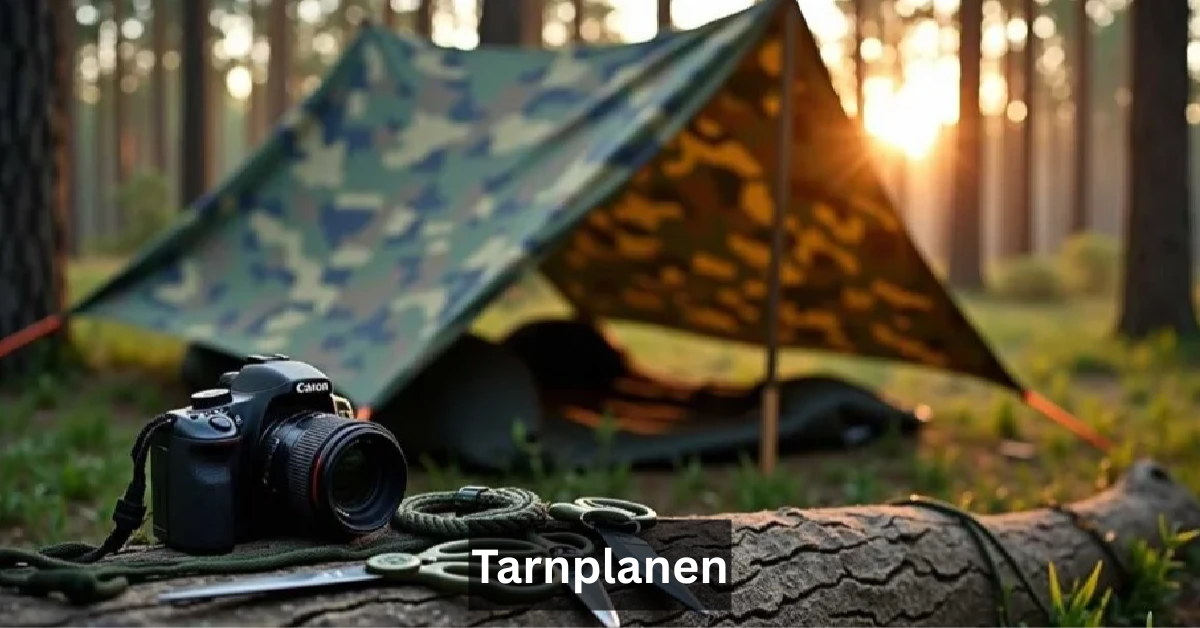When it comes to outdoor protection, concealment, and survival gear, few items are as versatile and reliable as a Tarnplanen. This German word translates to “camouflage tarpaulin” and has become a staple in military operations, outdoor adventures, and survivalist communities worldwide. A Tarnplanen combines strength, waterproofing, and camouflage patterns to create the ultimate tactical equipment cover. Whether you’re using it for camping, hunting, or as part of military field equipment, the Tarnplanen stands out as a trusted tool that can adapt to countless environments and purposes.
A Tarnplanen is essentially a camouflage tarpaulin designed to protect and conceal equipment, shelters, or personnel in outdoor environments. Unlike regular tarps, a Tarnplanen is made to blend seamlessly with its surroundings using advanced camouflage patterns such as Flecktarn, Splittertarn, Woodland camouflage, or Desert camo. This makes it more than just a waterproof sheet — it becomes part of your survival strategy, whether you are in thick forests, dry deserts, or snowy fields.
The difference between a regular tarp and a Tarnplanen lies in its construction and purpose. While a plastic tarp might provide basic rain protection, it won’t hide you or your equipment from view. A Tarnplanen, however, acts as a concealment equipment cover, making it invaluable for soldiers, hunters, bushcraft enthusiasts, and campers who require both protection and invisibility in the wilderness.
The History of Tarnplanen
The story of the Tarnplanen is deeply connected to European military history. During World War II, the German army introduced specialized camouflage tarpaulins, known for their iconic Splittertarn and Platanenmuster designs. These patterns revolutionized concealment by allowing soldiers to disguise themselves and their equipment in varied landscapes. WWII Wehrmacht camo tarps quickly proved their worth on the battlefield and influenced camouflage designs for decades to come.
Later, during the Cold War, the Bundeswehr (the German armed forces) developed the Flecktarn pattern, which remains one of the most effective and recognizable camouflages used in NATO military gear. Over time, the Tarnplanen evolved from heavy canvas sheets to lightweight, waterproof tarps made of polyester, polyethylene, or ripstop fabric. Today, they are not just limited to the battlefield; the Tarnplanen has become a staple for survivalists, preppers, hunters, and outdoor enthusiasts around the world.
Materials and Construction of Tarnplanen
A Tarnplanen is built to endure. Modern designs use tough materials such as polyester, canvas, PVC, polyethylene, and ripstop nylon, making them resistant to harsh weather and heavy use. Unlike standard tarpaulins, the Tarnplanen often includes reinforced corners, heavy-duty eyelets, and double-stitched seams, giving it the strength needed for both military and outdoor survival situations.
Another essential aspect of Tarnplanen construction is waterproofing and UV resistance. Whether you are setting up camp in a rainy forest or using it as an army tent tarp in the desert, a Tarnplanen ensures your gear remains dry and safe. Military-grade tarps are often coated with PVC for durability, while lighter versions for bushcraft enthusiasts use breathable ripstop fabrics that provide a balance between concealment and comfort.
Types of Tarnplanen
The Tarnplanen comes in various types designed for specific uses:
Military Camouflage Tarps
Used in NATO countries and beyond, these are standard issue for soldiers needing concealment and protection in the field.
Hunting and Outdoor Camo Covers
Hunters rely on hunting camo tarps to create blinds and concealment shelters.
Heavy-Duty Camouflage Tarpaulins
Perfect for industrial use, these heavy-duty camouflage tarpaulins cover vehicles, equipment, or even field hospitals.
Bushcraft and Survival Gear Tarps
Lightweight versions of Tarnplanen are essential for bushcraft equipment, doubling as shelters, groundsheets, or weatherproof camping covers.
Tent Accessories and Camo Groundsheets
Many outdoor enthusiasts use Tarnplanen as an additional tent accessory, protecting the base of tents and keeping interiors dry.
Camouflage Patterns in Tarnplanen
The effectiveness of a Tarnplanen largely depends on its camouflage pattern.
- Flecktarn: The iconic German pattern, still widely used in Europe.
- Splittertarn: A historic WWII design, famous among collectors.
- Woodland Camouflage: Popular in the USA hunting market, perfect for dense forests.
- Desert Camo: Developed for arid regions, useful for NATO deployments in desert zones.
Modern digital camouflage tarps are also gaining popularity, blending pixel-like designs for more effective concealment in multiple terrains. Whether for military surplus or outdoor survival brands, these patterns ensure a Tarnplanen remains one of the most trusted concealment tools.
Practical Uses of Tarnplanen
The Tarnplanen is versatile and practical across countless scenarios:
- Military and Tactical Field Operations: Used to conceal vehicles, weapons, and camps.
- Camping and Backpacking Shelters: Provides lightweight, waterproof protection.
- Bushcraft and Survival Scenarios: Works as an improvised shelter or groundsheet.
- Hunting Blinds: Helps hunters remain hidden while observing wildlife.
- Disaster Relief and Field Hospitals: A Tarnplanen can quickly provide cover and shade in emergencies.
- Airsoft and Paintball: Players use Tarnplanen for realistic concealment in tactical games.
Tarnplanen for Outdoor Enthusiasts
For campers, hikers, and survivalists, the Tarnplanen is an all-in-one solution. It is lightweight, compact, and designed for multiple uses, making it easy to carry in a backpack. Beyond concealment, it provides weather protection, waterproof camping covers, and gear concealment. Many outdoor enthusiasts consider the Tarnplanen a non-negotiable part of their kit.
Buying Guide – How to Choose the Right Tarnplanen
When purchasing a Tarnplanen, consider the following:
- Size and Weight: Larger tarps are great for group shelters, smaller ones for solo survival kits.
- Material Quality: Look for strong fabrics like ripstop polyester or PVC-coated canvas.
- Waterproof vs. Breathable: Choose based on your climate and intended use.
- Reinforced Eyelets: These make setup easier and more secure.
Military Surplus vs. Commercial Products: Bundeswehr surplus often provides excellent quality at lower prices, while brands like Mil-Tec, Helikon-Tex, Carinthia, and Tasmanian Tiger offer modern versions with advanced features.
Top Brands and Sources for Tarnplanen
You can find Tarnplanen in multiple places:
- Military Surplus Stores: Especially in Germany, NATO countries, and Europe.
- Outdoor Brands: Leading names include Mil-Tec, Helikon-Tex, Tasmanian Tiger, Carinthia.
- Online Marketplaces: Platforms like Amazon, eBay, and Decathlon offer both surplus and new gear.
The choice between surplus and new gear depends on budget and intended use. Surplus gear is affordable and battle-tested, while new products often feature modern fabrics and coatings.
Tarnplanen Care and Maintenance
A Tarnplanen will last years if cared for properly. Always clean and dry your camouflage tarpaulin after use to prevent mold. Store it in a cool, dry place to avoid fabric degradation. If holes or tears appear, patch kits are available to extend its life. Some users apply waterproofing sprays to renew water resistance.
Tarnplanen in Modern Survival and Prepper Culture
Among preppers and bushcraft enthusiasts, the Tarnplanen has become essential. It’s a core item in bug-out bags, valued for its role in building DIY shelters, providing concealment, and protecting supplies. In prepper culture, few items are as versatile, affordable, and effective as a Tarnplanen.
Environmental Impact of Tarnplanen
While some Tarnplanen are made of plastics like polyethylene and PVC, many brands are now exploring eco-friendly alternatives. Because they are highly durable and reusable, they reduce waste compared to single-use covers. Choosing long-lasting materials and responsibly disposing of old tarps ensures the environmental footprint remains minimal.
Conclusion
Tarnplanen, born in WWII, embodies resilience and adaptability—still vital today for camping, survival, hunting, and tactical concealment. For military professionals, preppers, hunters, and outdoor adventurers, a Tarnplanen is not an accessory but a necessity — a trusted companion in the unpredictable outdoors.
Frequently Asked Questions
Are Tarnplanen fully waterproof?
Yes, most Tarnplanen are waterproof, though the degree depends on material and coating.
Can camouflage tarpaulins be used as tents?
Yes, a Tarnplanen can be rigged into a tent, lean-to, or shelter with ropes and poles.
Where can I buy authentic military surplus Tarnplanen?
Check Bundeswehr surplus stores, NATO military gear outlets, or online marketplaces.
What is the difference between Flecktarn and Woodland patterns?
Flecktarn is a German pattern using dotted camouflage, while Woodland is an American pattern suited for dense forests.
How long does a heavy-duty Tarnplanen last?
With proper care, a heavy-duty camouflage tarpaulin can last for years, even in harsh environments.



